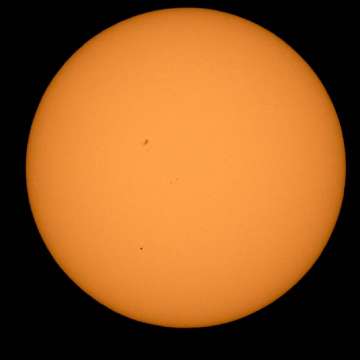In a rare phenomenon, Mercury will pass through the Sun on Monday and will be visible from Earth as a tiny black dot crawling across the face of the Sun. The phenomenon is expected to last about five and a half hours. According to NASA, Mercury will begin its transit at about 7:35 a.m. EST to 1:04 p.m. EST. This is a transit and it happens when Mercury lines up just right between the Sun and Earth, NASA said.
Mercury transits happen about 13 times a century. Though it takes Mercury only about 88 days to zip around the Sun, its orbit is tilted, so it’s relatively rare for the Sun, Mercury and Earth to line up perfectly.
The next Mercury transit isn’t happening until 2032 — and in the U.S., the next opportunity to catch a Mercury transit is in 2049, the space agency said.
For observers in the Eastern U.S., the transit begins after sunrise, meaning you'll be able to view the entire thing. For the central and western U.S., the transit begins before sunrise, but there's enough time left as the Sun climbs up the sky for you to catch a glimpse before Mercury makes its exit.
What does Mercury transit mean?
A transit of Mercury across the Sun takes place when the planet Mercury passes directly (transits) between the Sun and a superior planet, becoming visible against (and hence obscuring a small portion of) the solar disk. Transits of Mercury occur in May or November.
Mercury passes from in between Earth and Sun today
How to watch Mercury transit?
Mercury transit can best be viewed using a telescope with a certified sun filter, but other options include solar projection boxes and sun funnels. Plus, NASA's Solar Dynamics Observatory spacecraft will be sharing near-realtime images during the transit.
Is it safe to watch Mercury transit with naked eye?
It is just not safe to watch the transit from the ground and one should avoid looking at the Sun directly. Even with solar viewing glasses, Mercury is too small to be easily seen with the unaided eye. Your local astronomy club may have an opportunity to see the transit using specialized, properly-filtered solar telescopes — but remember that you cannot use a regular telescope or binoculars in conjunction with solar viewing glasses.
In which countries will Mercury transit be visible?
The entire 5-hour event will be visible in the eastern US and Canada and in Central and South America. The rest of North America, Europe and Africa will catch part of the action. The phenomenon will not be visible in Asia and Australia.
Also Read | NASA showcases its first all-electric aircraft
Also Read | Amazon rainforest is drying up since 2 decades, says NASA
